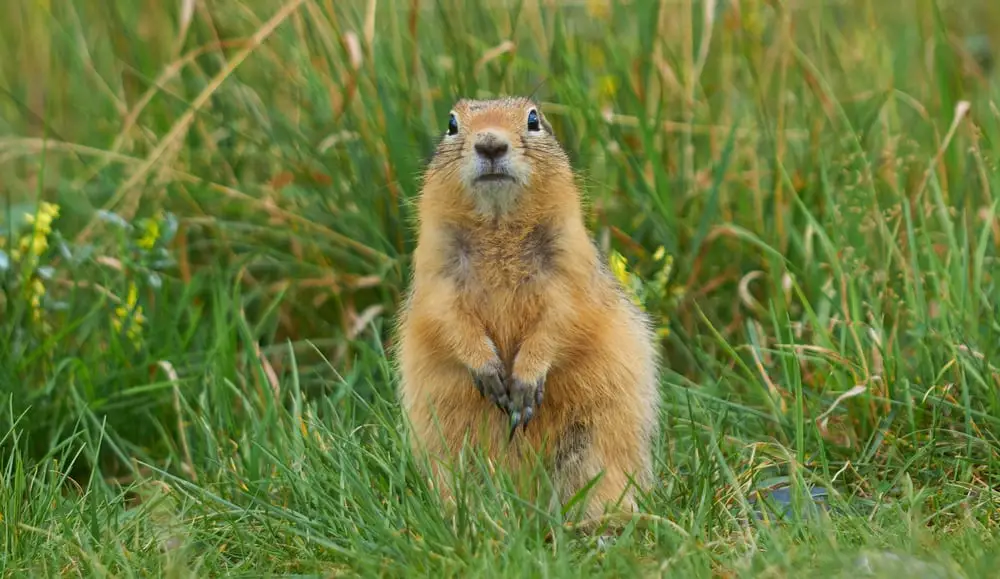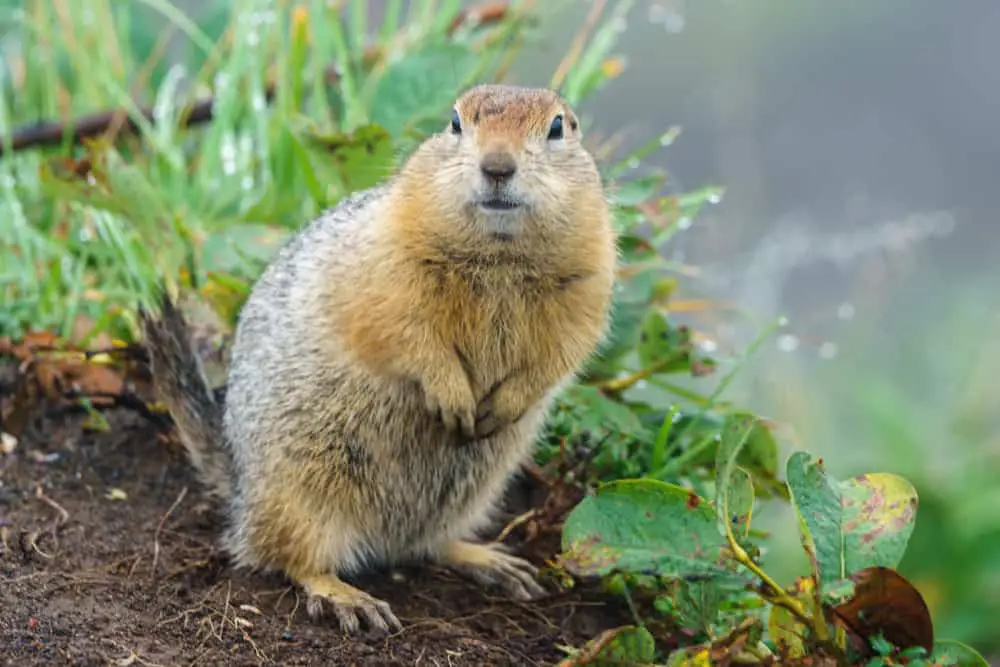A gopher is a small burrowing rodent, of the family Geomyidae. The most common species of gophers are found in North America and measure between five and fourteen inches long from head to tail. Gophers have short fur that varies in color ranging from grayish-brown to almost black. They also have prominent front claws for digging, beady eyes and ears, and large cheek pouches used for carrying food.

Definition
A gopher is a small burrowing rodent, of the family Geomyidae. The most common species of gophers are found in North America and measure between five and fourteen inches long from head to tail. Gophers have short fur that varies in color ranging from grayish-brown to almost black. They also have prominent front claws for digging, beady eyes and ears, and large cheek pouches used for carrying food.
Gopher meaning refers to their primary activity: burrowing. In order to create a home underground, they use their powerful front legs and sharp claws to dig extensive tunnel systems – some reaching up to three hundred feet long! Their burrows provide them with protection from predators as well as insulation during cold weather conditions. Additionally, these tunnels often form intricate networks connecting living spaces together while providing access to many different food sources such as roots, fruits and seeds.
Burrowing definition can also refer to other animals’ activities such as rabbits or badgers who inhabit similar habitats as gophers do but only on a much smaller scale. Despite being classified into the same taxonomic family, there are several differences between these two rodents which include size (gophers tending to be larger than either rabbits or badgers), behavior (gophers being more solitary) and diet (gophers being omnivorous).
| Common Name | Scientific Name | Location |
|---|---|---|
| Northern Pocket Gopher | Thomomys talpoides | North America |
| Plains Pocket Gopher | Geomys bursarius | Central and Eastern United States |
| Botta’s Pocket Gopher | Thomomys bottae | Western United States |
| Idaho Pocket Gopher | Thomomys idahoensis | Northwestern United States |
| Mazama Pocket Gopher | Orthogeomys spp. | Central and South America |
| Mexican Pocket Gopher | Cratogeomys mexicanus | Mexico and Central America |
Appearance And Behavior
Having established the definition of a gopher, it is important to understand the animal’s appearance and behavior. Generally, gophers are stout animals with a wide head and small ears that have fur-lined cheek pouches for storing food when foraging.
Their bodies range from 4 – 13 inches in length, and vary in color depending on their geographical location; some of which include blackish brown, gray, yellowish-brown, or reddish-brown. In addition to these physical features, gophers exhibit certain behaviors such as burrowing underground using their powerful front legs and claws.
Gophers typically live alone but may interact socially with other members of its species near tunnels that they create in order to increase ventilation below ground. They demonstrate various foraging strategies including collecting nuts and seeds, grasses or roots while also consuming insects such as beetles and caterpillars if available. Gophers will store harvested items into their cheek pouches before taking them back to their burrows where they can later be consumed.
Though not entirely nocturnal creatures like many rodents, gophers tend to remain within their subterranean tunnel systems during daylight hours due to the presence of predators aboveground.
As a result, most activity takes place at night when fewer threats exist outside the safety of their holes and dens. This combination of external characteristics coupled with specific behaviors make gophers unique compared to other mammals living in similar habitats around the world today.
Habitat
Gophers are small burrowing mammals that inhabit a variety of habitats. These include:
- Grasslands
- Wetlands
- Underground tunnels
- Forests
The gopher’s extensive underground tunnel system is an important part of its habitat, providing protection from predators and access to food sources. Gophers dig their tunnels with strong front claws and use them to store food for later consumption; the burrows can reach depths of up to 10 feet in some cases. They feed on roots, tubers, grasses, and other vegetation found near their burrow entrance.
Because of their reliance on natural vegetation for sustenance, gophers often thrive in areas where there is plenty of greenery or farmland nearby. The presence of gophers indicates healthy soil quality as well as adequate water levels necessary for plant growth. Their presence also creates opportunities for new plants to take root and spread across different areas due to the loosening effect caused by the animals’ digging habits. In turn, this helps maintain biodiversity within ecosystems.
Gophers play an integral role in many environments around the world by helping sustain fragile ecosystems through nutrient recycling and aiding in seed dispersal processes. As such, they are key components of these varied habitats that need protecting if we want to preserve our precious resources for future generations.
Diet
Gophers are omnivorous animals, consuming a variety of plant and animal matter as part of their diet. Plant-based items form the majority of their diet; gophers feed on roots, bulbs, fruits and grasses. Insects such as grubs also make up an important component of their diets.
Gophers have unique incisors that allow them to dig easily in search for food and they use this skill to access underground food sources like roots and bulbs. They will often store surplus food supplies in caches located around the burrow system, which they can return to during lean times or when food is scarce.
Gophers also inhabit agricultural land where they consume crops planted by humans including potatoes, carrots, onions, melons and sweetcorn.
In order to maintain a healthy diet it is important for gophers to have access to a wide range of foods. As well as the insects previously mentioned they should be able to find ample amounts of fruits and vegetables both above ground and below ground.
This provides essential vitamins and minerals that help keep them in peak condition throughout all seasons of the year. In addition gophers need access to plenty of fresh water either from surface sources or dug wells within their burrows systems so that they stay hydrated at all times.
With these dietary needs met, gophers can go about living active lives with energy levels maintained throughout the day.
Predators And Adaptations
Gophers are small burrowing rodents that inhabit diverse ecosystems worldwide. As they feed on vegetables, grasses and other vegetation, they often become prey to a variety of predators. To evade these predators, gophers have developed various adaptations over time. These include scent-marking, avoidance tactics and camouflage patterns.
| Predator | Adaptation | Examples |
|---|---|---|
| Coyotes | Scent Marking | Chewing stems of plants Spraying urine in tunnels Rubbing fur against objects Producing loud noises Burying food items for later use |
| Foxes & Weasels | Avoidance Tactics | Digging deeper tunnels Staying close to their burrows Traveling underground through existing tunnels instead of above ground Building multiple exits into their burrow systems Moving quickly when exposed outside the tunnel system |
| Birds of Prey | Camouflage Patterns | Growing coarse fur with mottled colors matching the environment around them Swimming underwater or hiding beneath aquatic vegetation while hunting near bodies of water Remaining motionless when threatened by an aerial predator Developing protective coloration resembling rocks or tree bark that blends into its surroundings |
Adaptations such as scent-marking, avoidance-tactics, and camouflage-patterns have enabled Gophers to survive generations of predation from Coyotes, Foxes & Weasels, and Birds of Prey alike. By understanding how these strategies work together to protect them from danger, we can better appreciate Gopher’s remarkable ability to thrive despite numerous threats posed by nature.

Reproduction
Gophers are well known for their prolific breeding habits and the ability to rapidly reproduce. They typically breed in early spring, with gestation periods of around 21 days. One litter may consist of up to six cubs, although three or four is more common. The young gopher will remain with its mother until it reaches independence at two months old.
Mating behaviours vary depending on species; some use vocalizations while others have scent marking rituals. Gophers engage in monogamy, raising offspring together as a pair within a burrow system that can span several acres in size. Females mate only once per season but males may try to mate with multiple females over the course of one mating period.
At birth, gopher cubs are helpless and nearly hairless, about 10 centimeters long and weighing barely an ounce each. At this stage they depend entirely upon their mother’s milk for nourishment and protection from predators until they reach maturity at 2-3 months old when they disperse into their own densities and become independent adults.
Conservation Status
Gophers are becoming increasingly vulnerable due to their decreasing population numbers. As an endangered species, there is a need for conservation efforts to ensure the future of this small rodent. Gopher conservation has been hampered by habitat destruction and other human activities that threaten gopher populations in many areas.
Conservation strategies include educating people about the importance of protecting gopher habitats as well as reducing or eliminating any destructive activities such as plowing fields near burrows or trapping them for fur trade purposes. In addition, increasing public awareness of the value that these animals bring to their environment can help increase support for gopher conservation initiatives.
To counteract the effects of population decline, research suggests implementing measures to improve survival rates including creating protected habitats, reintroduction programs and providing supplemental food sources when natural resources become scarce. With continued attention towards preserving gophers, we can hope to see a brighter future for these important members of our ecosystems.
Conclusion
The gopher is an industrious species of rodent found throughout much of North America. Its distinctive, stout body and short legs give it a characteristic appearance that makes it easily recognizable in its natural habitat.
Gophers are well adapted to living underground, where they construct complex burrows that provide shelter from predators. They feed on a variety of plants and small animals, including roots, grasses, insects, worms and other invertebrates.
Gophers have several adaptations which help them survive predation by larger mammals such as foxes and coyotes. These include their ability to quickly disappear into the ground when threatened and their thick fur coats which offer protection against harsh weather conditions. Additionally, gophers can move large amounts of soil with their powerful claws for quickly constructing new burrows or repairing damaged ones.
Reproduction occurs during springtime with female gophers giving birth to litters of up to five young after a gestation period of approximately one month. The population size of these rodents has remained relatively stable over the years but this could change due to potential threats posed by human activities such as land development and pollution. Therefore, conservation measures should be taken to ensure the continued survival of this important species in its natural environment.

